MBA7061 Operations Management: Analysis of Muscat Insurance Company
VerifiedAdded on 2023/04/19
|28
|5034
|310
Case Study
AI Summary
This case study examines the operations management strategies employed by Muscat Insurance Company in Oman. It identifies and analyzes key elements such as capacity management, supply chain management, procurement, inventory management, quality management, customer service, risk management, competitive advantage, and sustainability. The report appraises scenarios for each element (positive, negative, and just right), evaluates the company's operational strategies, and recommends improvements to achieve operational excellence. It also includes an analysis of potential negative scenarios in capacity, supply chain, procurement, and quality management, along with suggestions for improvement. The case study concludes with overall recommendations for achieving operational excellence at Muscat Insurance Company.
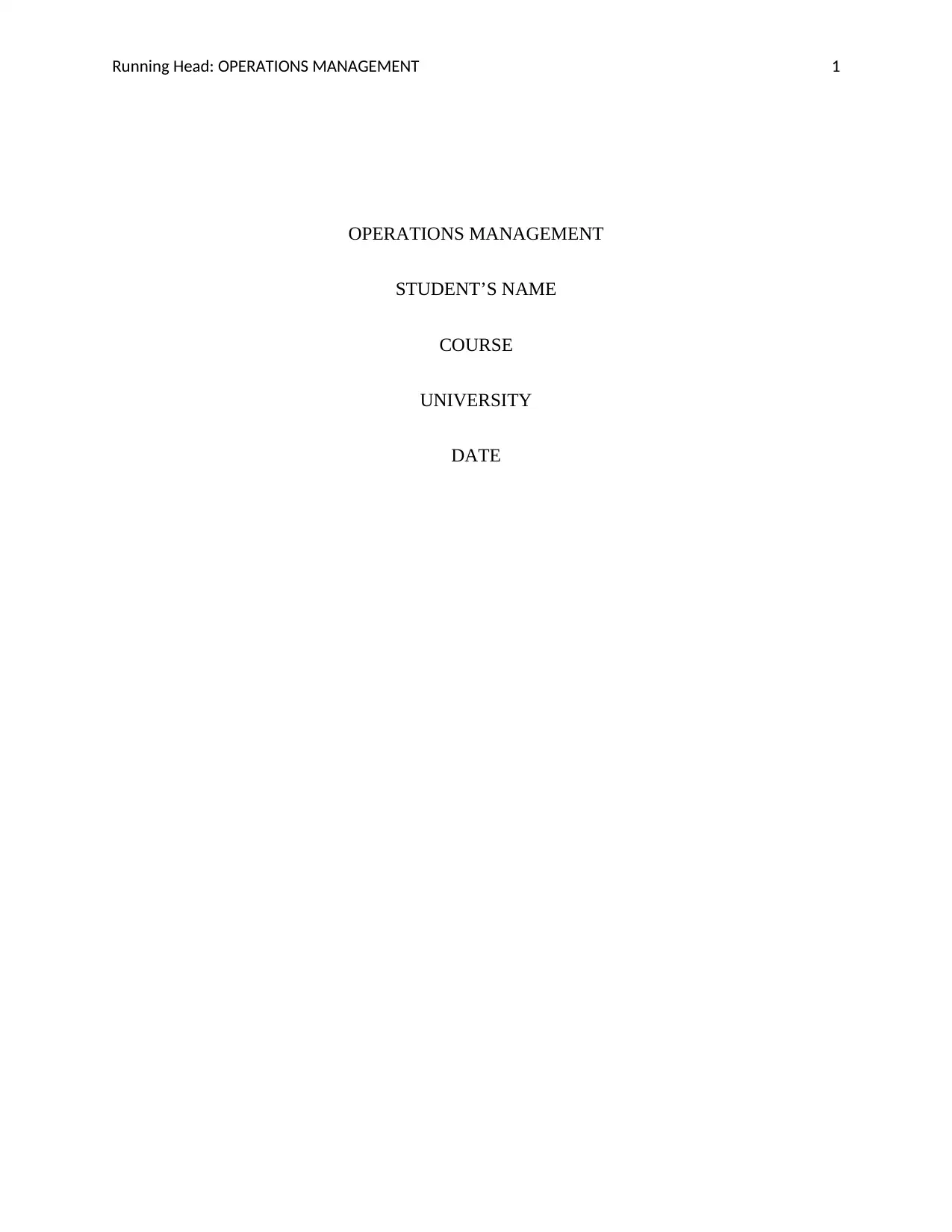
Running Head: OPERATIONS MANAGEMENT 1
OPERATIONS MANAGEMENT
STUDENT’S NAME
COURSE
UNIVERSITY
DATE
OPERATIONS MANAGEMENT
STUDENT’S NAME
COURSE
UNIVERSITY
DATE
Paraphrase This Document
Need a fresh take? Get an instant paraphrase of this document with our AI Paraphraser
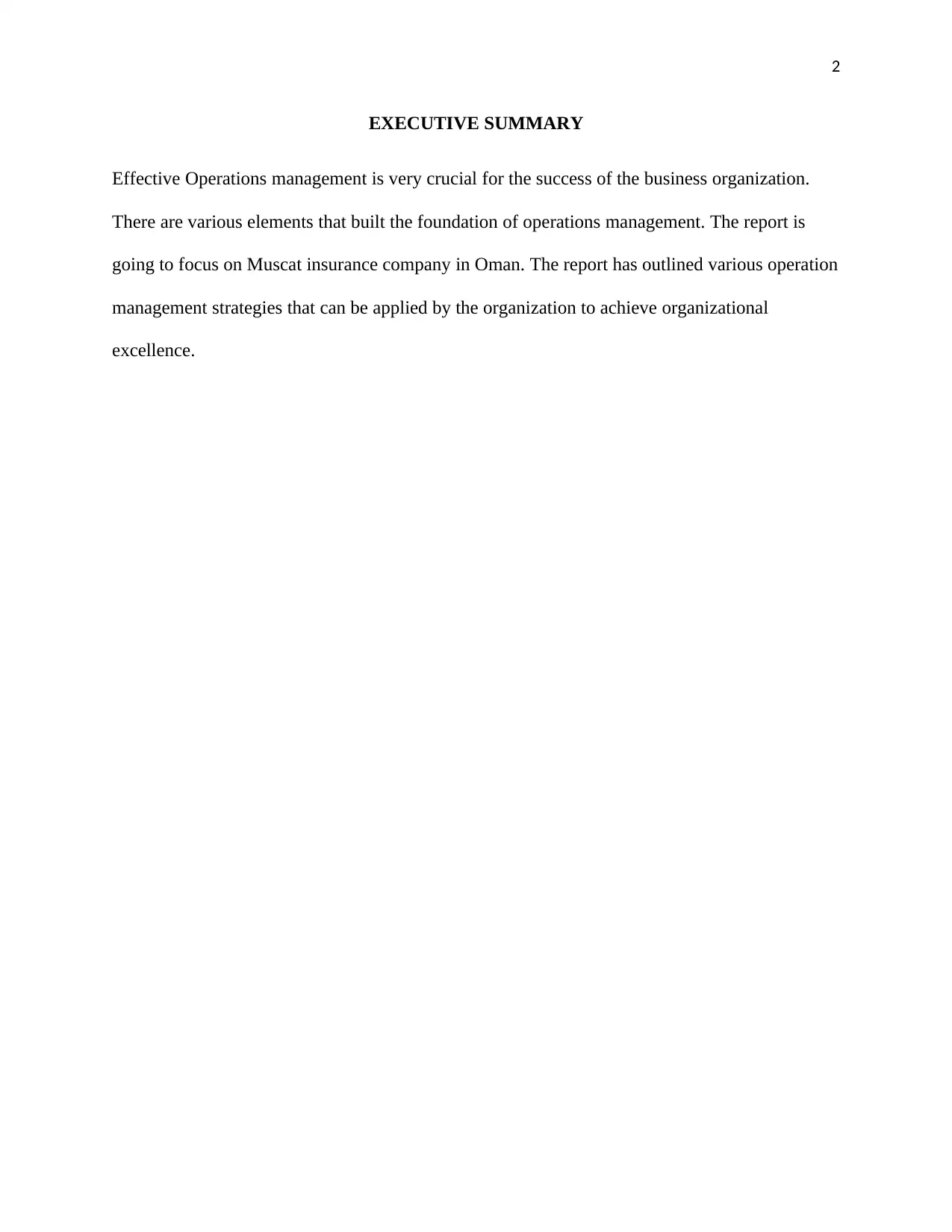
2
EXECUTIVE SUMMARY
Effective Operations management is very crucial for the success of the business organization.
There are various elements that built the foundation of operations management. The report is
going to focus on Muscat insurance company in Oman. The report has outlined various operation
management strategies that can be applied by the organization to achieve organizational
excellence.
EXECUTIVE SUMMARY
Effective Operations management is very crucial for the success of the business organization.
There are various elements that built the foundation of operations management. The report is
going to focus on Muscat insurance company in Oman. The report has outlined various operation
management strategies that can be applied by the organization to achieve organizational
excellence.
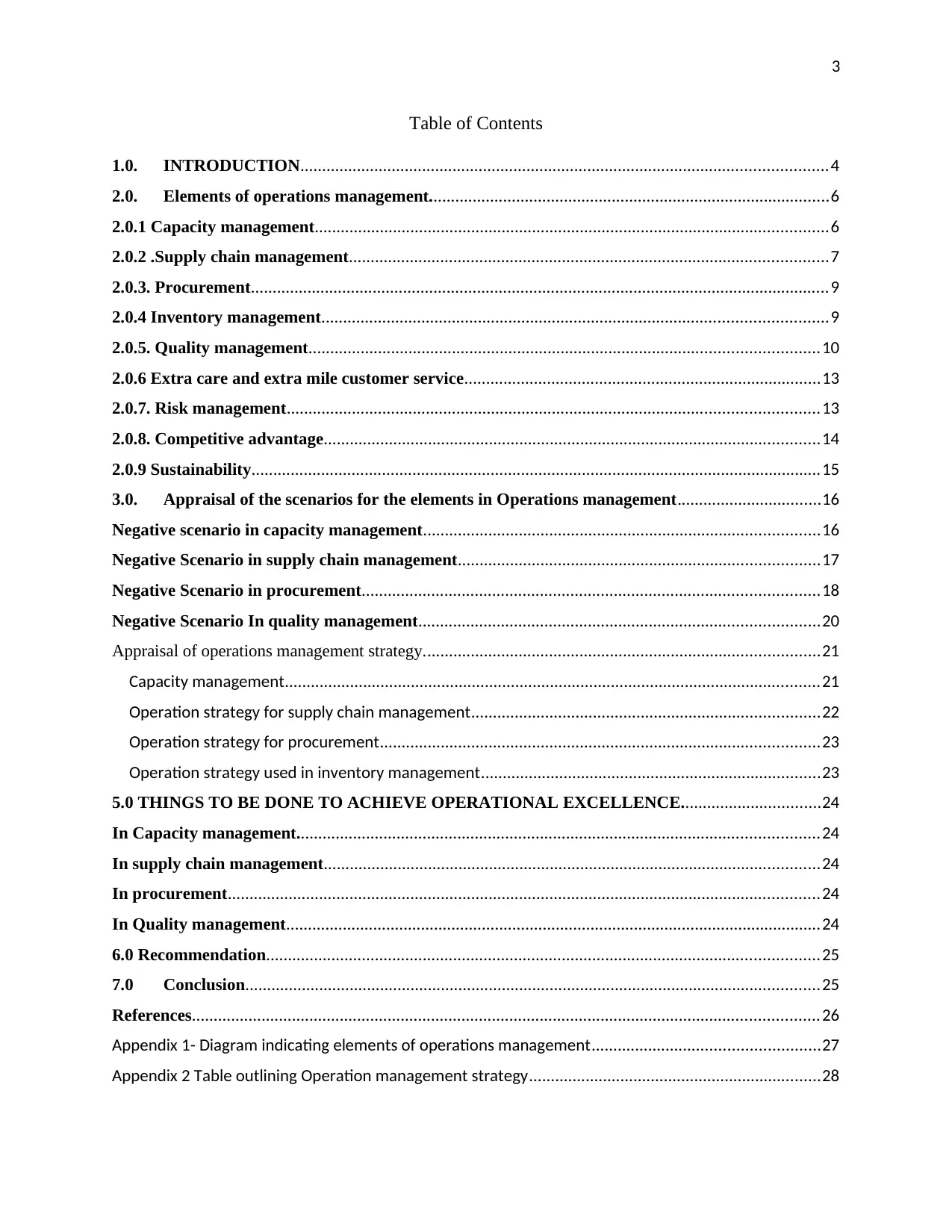
3
Table of Contents
1.0. INTRODUCTION.........................................................................................................................4
2.0. Elements of operations management............................................................................................6
2.0.1 Capacity management......................................................................................................................6
2.0.2 .Supply chain management..............................................................................................................7
2.0.3. Procurement.....................................................................................................................................9
2.0.4 Inventory management....................................................................................................................9
2.0.5. Quality management.....................................................................................................................10
2.0.6 Extra care and extra mile customer service..................................................................................13
2.0.7. Risk management..........................................................................................................................13
2.0.8. Competitive advantage..................................................................................................................14
2.0.9 Sustainability...................................................................................................................................15
3.0. Appraisal of the scenarios for the elements in Operations management.................................16
Negative scenario in capacity management...........................................................................................16
Negative Scenario in supply chain management...................................................................................17
Negative Scenario in procurement.........................................................................................................18
Negative Scenario In quality management............................................................................................20
Appraisal of operations management strategy...........................................................................................21
Capacity management...........................................................................................................................21
Operation strategy for supply chain management................................................................................22
Operation strategy for procurement.....................................................................................................23
Operation strategy used in inventory management..............................................................................23
5.0 THINGS TO BE DONE TO ACHIEVE OPERATIONAL EXCELLENCE................................24
In Capacity management........................................................................................................................24
In supply chain management..................................................................................................................24
In procurement........................................................................................................................................24
In Quality management...........................................................................................................................24
6.0 Recommendation...............................................................................................................................25
7.0 Conclusion....................................................................................................................................25
References................................................................................................................................................26
Appendix 1- Diagram indicating elements of operations management....................................................27
Appendix 2 Table outlining Operation management strategy...................................................................28
Table of Contents
1.0. INTRODUCTION.........................................................................................................................4
2.0. Elements of operations management............................................................................................6
2.0.1 Capacity management......................................................................................................................6
2.0.2 .Supply chain management..............................................................................................................7
2.0.3. Procurement.....................................................................................................................................9
2.0.4 Inventory management....................................................................................................................9
2.0.5. Quality management.....................................................................................................................10
2.0.6 Extra care and extra mile customer service..................................................................................13
2.0.7. Risk management..........................................................................................................................13
2.0.8. Competitive advantage..................................................................................................................14
2.0.9 Sustainability...................................................................................................................................15
3.0. Appraisal of the scenarios for the elements in Operations management.................................16
Negative scenario in capacity management...........................................................................................16
Negative Scenario in supply chain management...................................................................................17
Negative Scenario in procurement.........................................................................................................18
Negative Scenario In quality management............................................................................................20
Appraisal of operations management strategy...........................................................................................21
Capacity management...........................................................................................................................21
Operation strategy for supply chain management................................................................................22
Operation strategy for procurement.....................................................................................................23
Operation strategy used in inventory management..............................................................................23
5.0 THINGS TO BE DONE TO ACHIEVE OPERATIONAL EXCELLENCE................................24
In Capacity management........................................................................................................................24
In supply chain management..................................................................................................................24
In procurement........................................................................................................................................24
In Quality management...........................................................................................................................24
6.0 Recommendation...............................................................................................................................25
7.0 Conclusion....................................................................................................................................25
References................................................................................................................................................26
Appendix 1- Diagram indicating elements of operations management....................................................27
Appendix 2 Table outlining Operation management strategy...................................................................28
⊘ This is a preview!⊘
Do you want full access?
Subscribe today to unlock all pages.

Trusted by 1+ million students worldwide
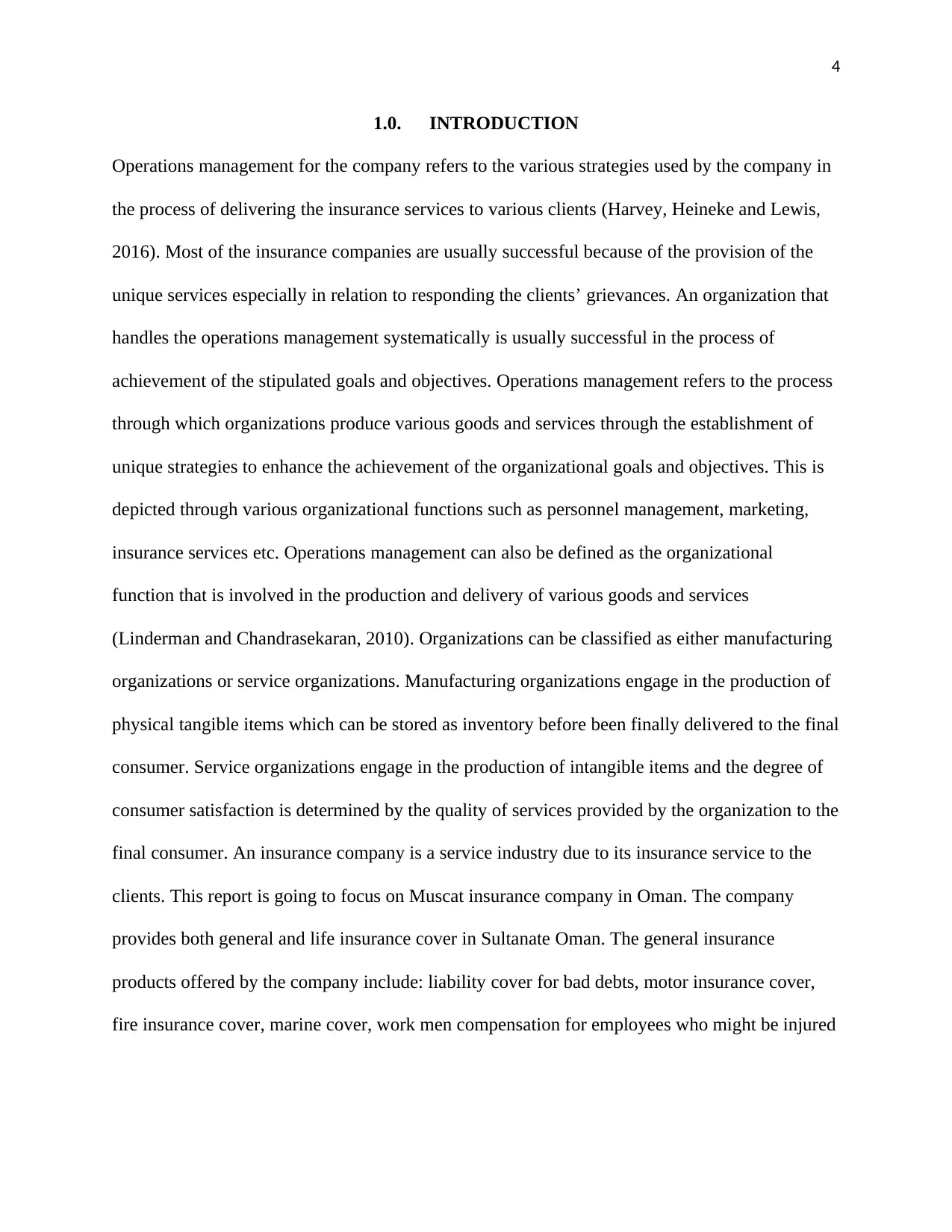
4
1.0. INTRODUCTION
Operations management for the company refers to the various strategies used by the company in
the process of delivering the insurance services to various clients (Harvey, Heineke and Lewis,
2016). Most of the insurance companies are usually successful because of the provision of the
unique services especially in relation to responding the clients’ grievances. An organization that
handles the operations management systematically is usually successful in the process of
achievement of the stipulated goals and objectives. Operations management refers to the process
through which organizations produce various goods and services through the establishment of
unique strategies to enhance the achievement of the organizational goals and objectives. This is
depicted through various organizational functions such as personnel management, marketing,
insurance services etc. Operations management can also be defined as the organizational
function that is involved in the production and delivery of various goods and services
(Linderman and Chandrasekaran, 2010). Organizations can be classified as either manufacturing
organizations or service organizations. Manufacturing organizations engage in the production of
physical tangible items which can be stored as inventory before been finally delivered to the final
consumer. Service organizations engage in the production of intangible items and the degree of
consumer satisfaction is determined by the quality of services provided by the organization to the
final consumer. An insurance company is a service industry due to its insurance service to the
clients. This report is going to focus on Muscat insurance company in Oman. The company
provides both general and life insurance cover in Sultanate Oman. The general insurance
products offered by the company include: liability cover for bad debts, motor insurance cover,
fire insurance cover, marine cover, work men compensation for employees who might be injured
1.0. INTRODUCTION
Operations management for the company refers to the various strategies used by the company in
the process of delivering the insurance services to various clients (Harvey, Heineke and Lewis,
2016). Most of the insurance companies are usually successful because of the provision of the
unique services especially in relation to responding the clients’ grievances. An organization that
handles the operations management systematically is usually successful in the process of
achievement of the stipulated goals and objectives. Operations management refers to the process
through which organizations produce various goods and services through the establishment of
unique strategies to enhance the achievement of the organizational goals and objectives. This is
depicted through various organizational functions such as personnel management, marketing,
insurance services etc. Operations management can also be defined as the organizational
function that is involved in the production and delivery of various goods and services
(Linderman and Chandrasekaran, 2010). Organizations can be classified as either manufacturing
organizations or service organizations. Manufacturing organizations engage in the production of
physical tangible items which can be stored as inventory before been finally delivered to the final
consumer. Service organizations engage in the production of intangible items and the degree of
consumer satisfaction is determined by the quality of services provided by the organization to the
final consumer. An insurance company is a service industry due to its insurance service to the
clients. This report is going to focus on Muscat insurance company in Oman. The company
provides both general and life insurance cover in Sultanate Oman. The general insurance
products offered by the company include: liability cover for bad debts, motor insurance cover,
fire insurance cover, marine cover, work men compensation for employees who might be injured
Paraphrase This Document
Need a fresh take? Get an instant paraphrase of this document with our AI Paraphraser
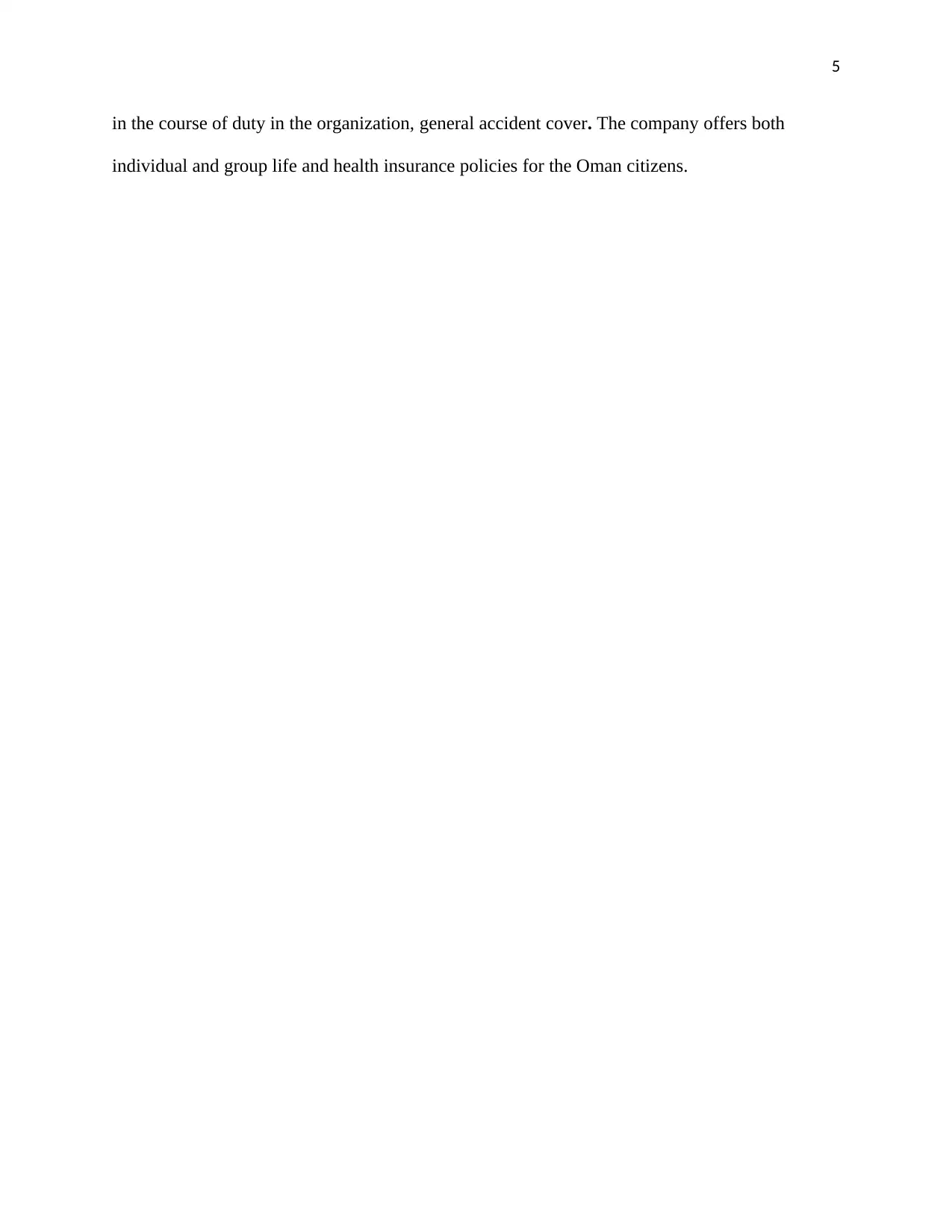
5
in the course of duty in the organization, general accident cover. The company offers both
individual and group life and health insurance policies for the Oman citizens.
in the course of duty in the organization, general accident cover. The company offers both
individual and group life and health insurance policies for the Oman citizens.
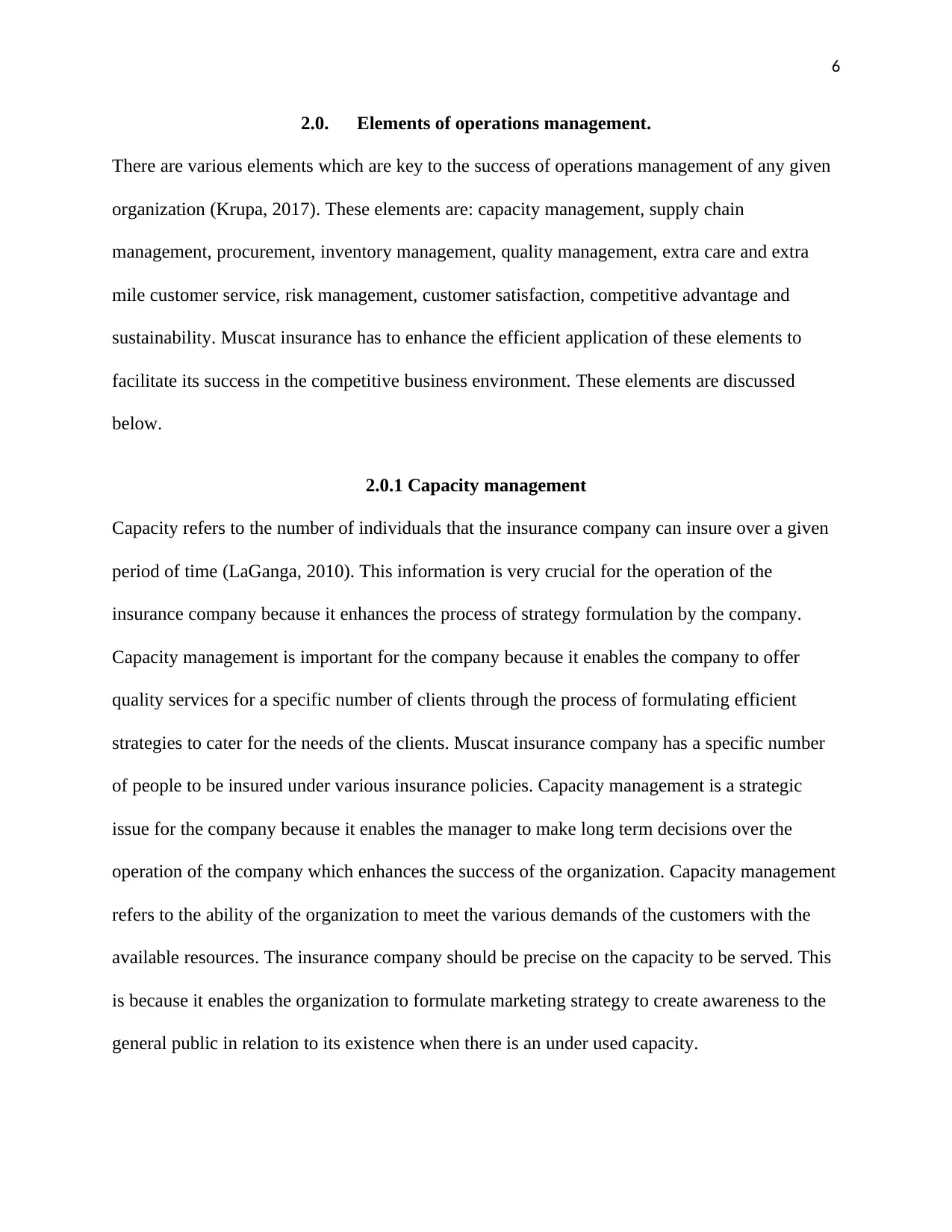
6
2.0. Elements of operations management.
There are various elements which are key to the success of operations management of any given
organization (Krupa, 2017). These elements are: capacity management, supply chain
management, procurement, inventory management, quality management, extra care and extra
mile customer service, risk management, customer satisfaction, competitive advantage and
sustainability. Muscat insurance has to enhance the efficient application of these elements to
facilitate its success in the competitive business environment. These elements are discussed
below.
2.0.1 Capacity management
Capacity refers to the number of individuals that the insurance company can insure over a given
period of time (LaGanga, 2010). This information is very crucial for the operation of the
insurance company because it enhances the process of strategy formulation by the company.
Capacity management is important for the company because it enables the company to offer
quality services for a specific number of clients through the process of formulating efficient
strategies to cater for the needs of the clients. Muscat insurance company has a specific number
of people to be insured under various insurance policies. Capacity management is a strategic
issue for the company because it enables the manager to make long term decisions over the
operation of the company which enhances the success of the organization. Capacity management
refers to the ability of the organization to meet the various demands of the customers with the
available resources. The insurance company should be precise on the capacity to be served. This
is because it enables the organization to formulate marketing strategy to create awareness to the
general public in relation to its existence when there is an under used capacity.
2.0. Elements of operations management.
There are various elements which are key to the success of operations management of any given
organization (Krupa, 2017). These elements are: capacity management, supply chain
management, procurement, inventory management, quality management, extra care and extra
mile customer service, risk management, customer satisfaction, competitive advantage and
sustainability. Muscat insurance has to enhance the efficient application of these elements to
facilitate its success in the competitive business environment. These elements are discussed
below.
2.0.1 Capacity management
Capacity refers to the number of individuals that the insurance company can insure over a given
period of time (LaGanga, 2010). This information is very crucial for the operation of the
insurance company because it enhances the process of strategy formulation by the company.
Capacity management is important for the company because it enables the company to offer
quality services for a specific number of clients through the process of formulating efficient
strategies to cater for the needs of the clients. Muscat insurance company has a specific number
of people to be insured under various insurance policies. Capacity management is a strategic
issue for the company because it enables the manager to make long term decisions over the
operation of the company which enhances the success of the organization. Capacity management
refers to the ability of the organization to meet the various demands of the customers with the
available resources. The insurance company should be precise on the capacity to be served. This
is because it enables the organization to formulate marketing strategy to create awareness to the
general public in relation to its existence when there is an under used capacity.
⊘ This is a preview!⊘
Do you want full access?
Subscribe today to unlock all pages.

Trusted by 1+ million students worldwide
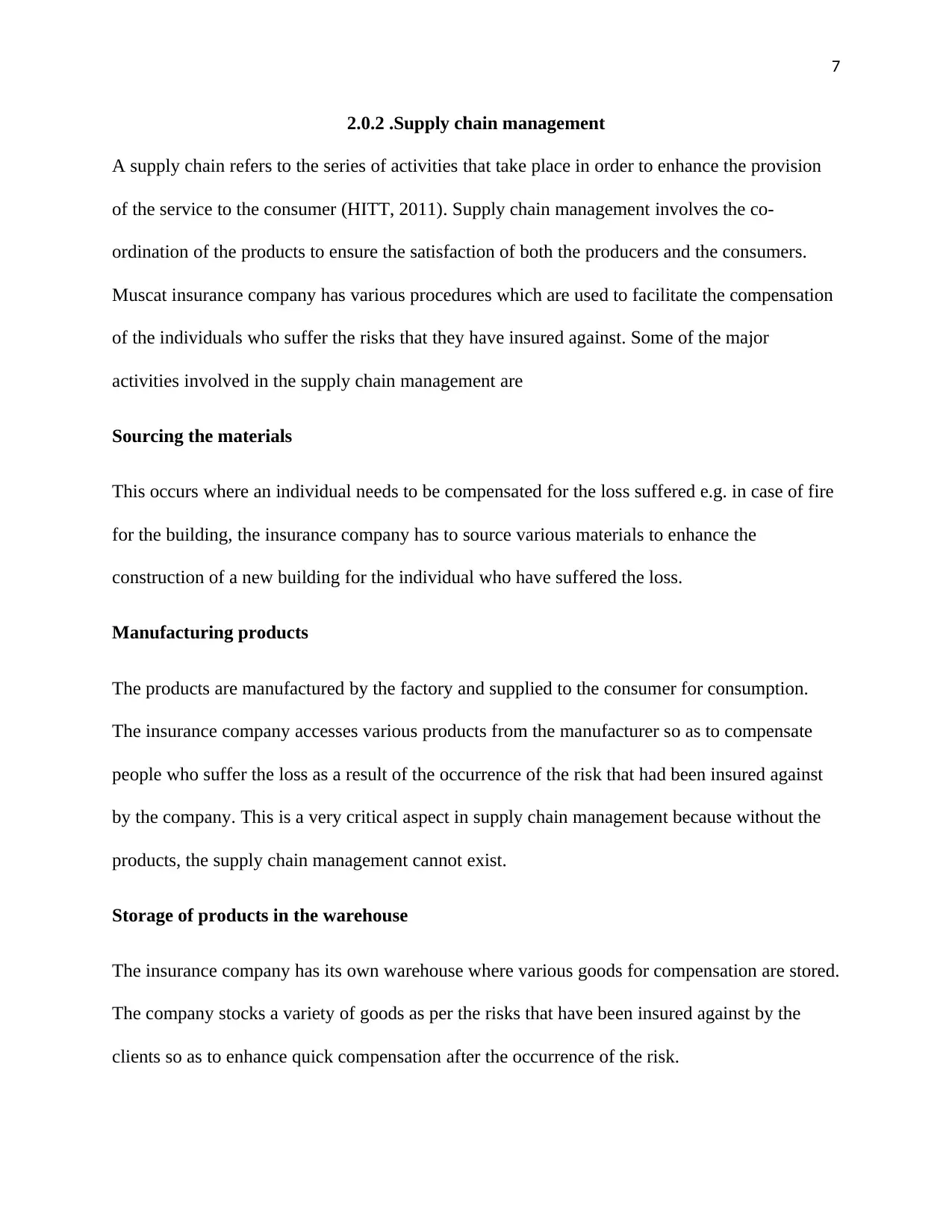
7
2.0.2 .Supply chain management
A supply chain refers to the series of activities that take place in order to enhance the provision
of the service to the consumer (HITT, 2011). Supply chain management involves the co-
ordination of the products to ensure the satisfaction of both the producers and the consumers.
Muscat insurance company has various procedures which are used to facilitate the compensation
of the individuals who suffer the risks that they have insured against. Some of the major
activities involved in the supply chain management are
Sourcing the materials
This occurs where an individual needs to be compensated for the loss suffered e.g. in case of fire
for the building, the insurance company has to source various materials to enhance the
construction of a new building for the individual who have suffered the loss.
Manufacturing products
The products are manufactured by the factory and supplied to the consumer for consumption.
The insurance company accesses various products from the manufacturer so as to compensate
people who suffer the loss as a result of the occurrence of the risk that had been insured against
by the company. This is a very critical aspect in supply chain management because without the
products, the supply chain management cannot exist.
Storage of products in the warehouse
The insurance company has its own warehouse where various goods for compensation are stored.
The company stocks a variety of goods as per the risks that have been insured against by the
clients so as to enhance quick compensation after the occurrence of the risk.
2.0.2 .Supply chain management
A supply chain refers to the series of activities that take place in order to enhance the provision
of the service to the consumer (HITT, 2011). Supply chain management involves the co-
ordination of the products to ensure the satisfaction of both the producers and the consumers.
Muscat insurance company has various procedures which are used to facilitate the compensation
of the individuals who suffer the risks that they have insured against. Some of the major
activities involved in the supply chain management are
Sourcing the materials
This occurs where an individual needs to be compensated for the loss suffered e.g. in case of fire
for the building, the insurance company has to source various materials to enhance the
construction of a new building for the individual who have suffered the loss.
Manufacturing products
The products are manufactured by the factory and supplied to the consumer for consumption.
The insurance company accesses various products from the manufacturer so as to compensate
people who suffer the loss as a result of the occurrence of the risk that had been insured against
by the company. This is a very critical aspect in supply chain management because without the
products, the supply chain management cannot exist.
Storage of products in the warehouse
The insurance company has its own warehouse where various goods for compensation are stored.
The company stocks a variety of goods as per the risks that have been insured against by the
clients so as to enhance quick compensation after the occurrence of the risk.
Paraphrase This Document
Need a fresh take? Get an instant paraphrase of this document with our AI Paraphraser
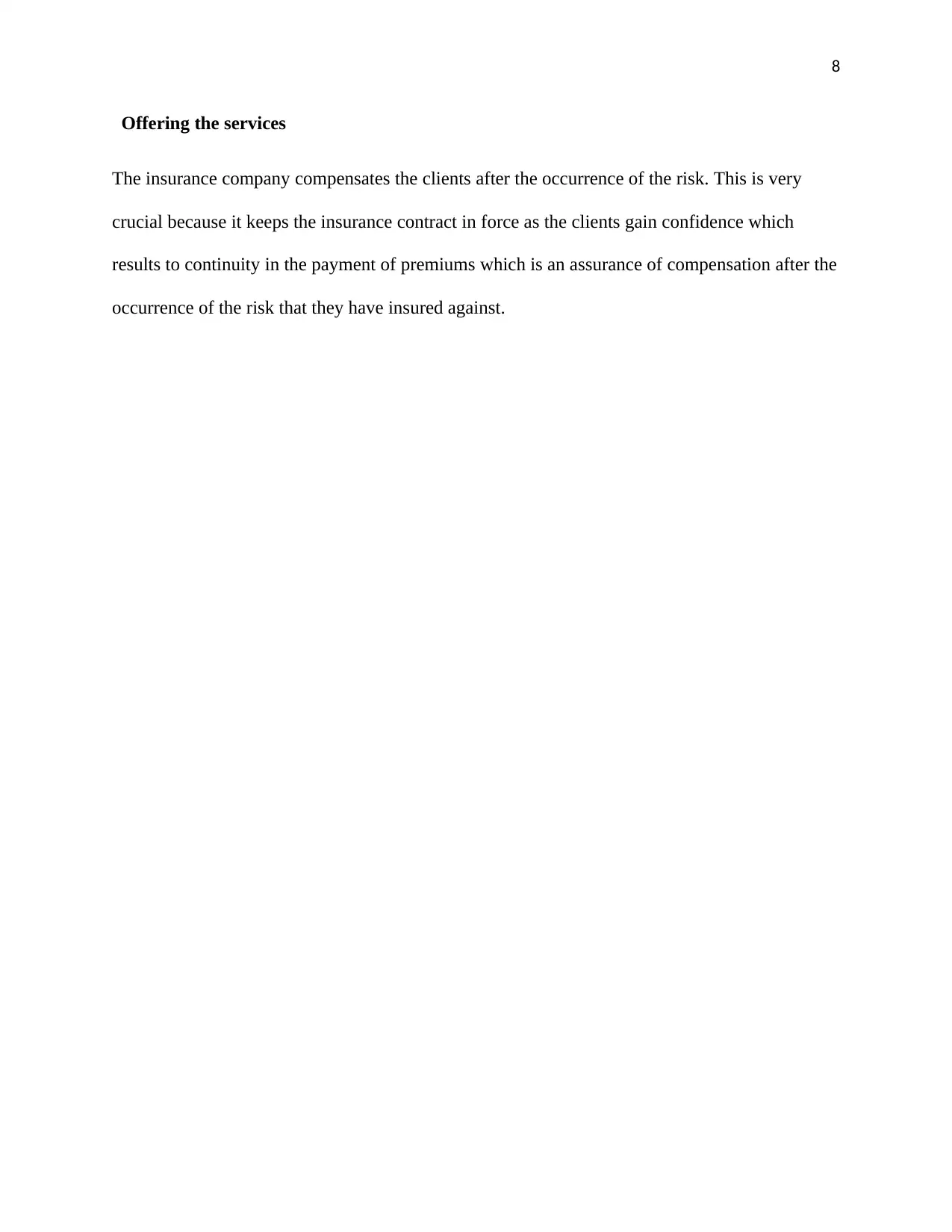
8
Offering the services
The insurance company compensates the clients after the occurrence of the risk. This is very
crucial because it keeps the insurance contract in force as the clients gain confidence which
results to continuity in the payment of premiums which is an assurance of compensation after the
occurrence of the risk that they have insured against.
Offering the services
The insurance company compensates the clients after the occurrence of the risk. This is very
crucial because it keeps the insurance contract in force as the clients gain confidence which
results to continuity in the payment of premiums which is an assurance of compensation after the
occurrence of the risk that they have insured against.
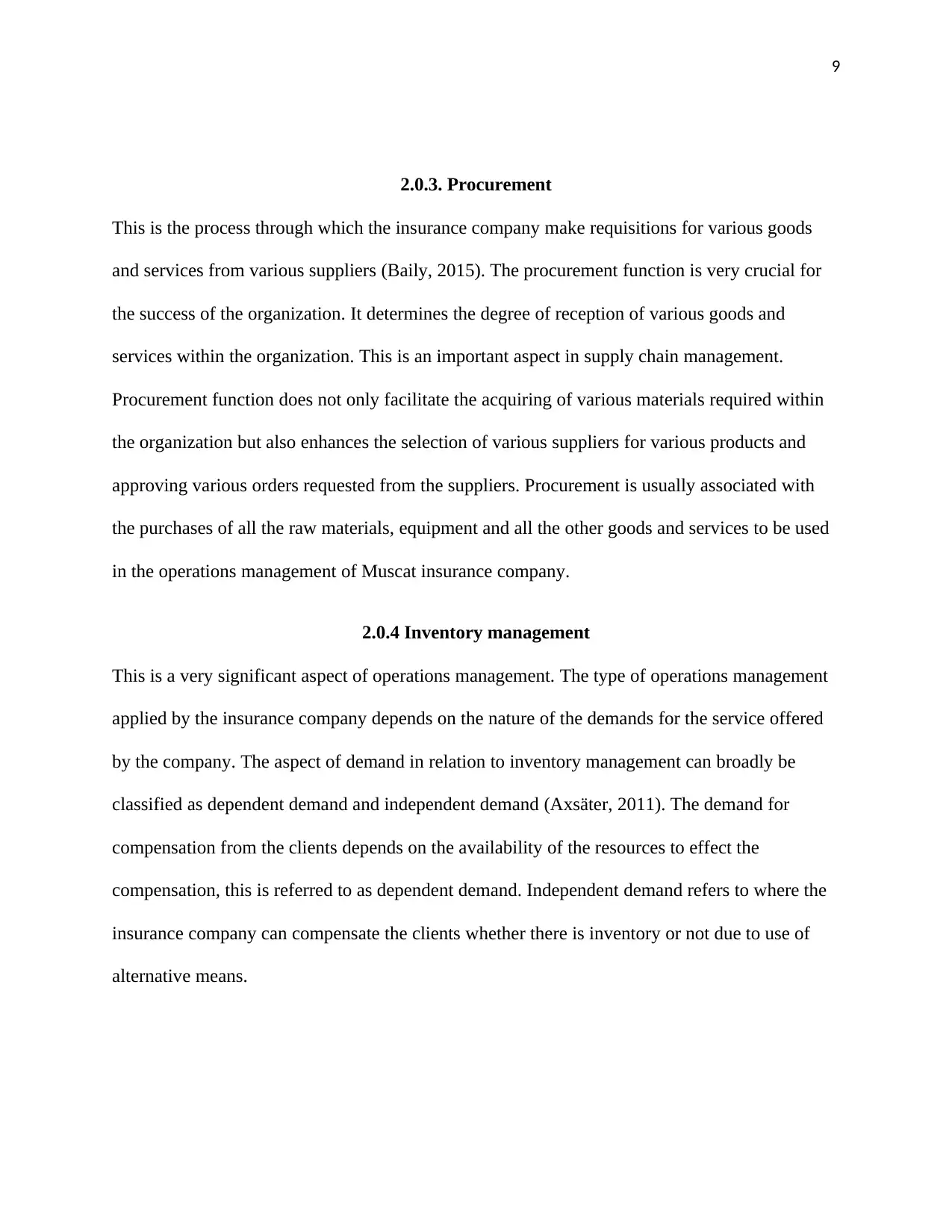
9
2.0.3. Procurement
This is the process through which the insurance company make requisitions for various goods
and services from various suppliers (Baily, 2015). The procurement function is very crucial for
the success of the organization. It determines the degree of reception of various goods and
services within the organization. This is an important aspect in supply chain management.
Procurement function does not only facilitate the acquiring of various materials required within
the organization but also enhances the selection of various suppliers for various products and
approving various orders requested from the suppliers. Procurement is usually associated with
the purchases of all the raw materials, equipment and all the other goods and services to be used
in the operations management of Muscat insurance company.
2.0.4 Inventory management
This is a very significant aspect of operations management. The type of operations management
applied by the insurance company depends on the nature of the demands for the service offered
by the company. The aspect of demand in relation to inventory management can broadly be
classified as dependent demand and independent demand (Axsäter, 2011). The demand for
compensation from the clients depends on the availability of the resources to effect the
compensation, this is referred to as dependent demand. Independent demand refers to where the
insurance company can compensate the clients whether there is inventory or not due to use of
alternative means.
2.0.3. Procurement
This is the process through which the insurance company make requisitions for various goods
and services from various suppliers (Baily, 2015). The procurement function is very crucial for
the success of the organization. It determines the degree of reception of various goods and
services within the organization. This is an important aspect in supply chain management.
Procurement function does not only facilitate the acquiring of various materials required within
the organization but also enhances the selection of various suppliers for various products and
approving various orders requested from the suppliers. Procurement is usually associated with
the purchases of all the raw materials, equipment and all the other goods and services to be used
in the operations management of Muscat insurance company.
2.0.4 Inventory management
This is a very significant aspect of operations management. The type of operations management
applied by the insurance company depends on the nature of the demands for the service offered
by the company. The aspect of demand in relation to inventory management can broadly be
classified as dependent demand and independent demand (Axsäter, 2011). The demand for
compensation from the clients depends on the availability of the resources to effect the
compensation, this is referred to as dependent demand. Independent demand refers to where the
insurance company can compensate the clients whether there is inventory or not due to use of
alternative means.
⊘ This is a preview!⊘
Do you want full access?
Subscribe today to unlock all pages.

Trusted by 1+ million students worldwide
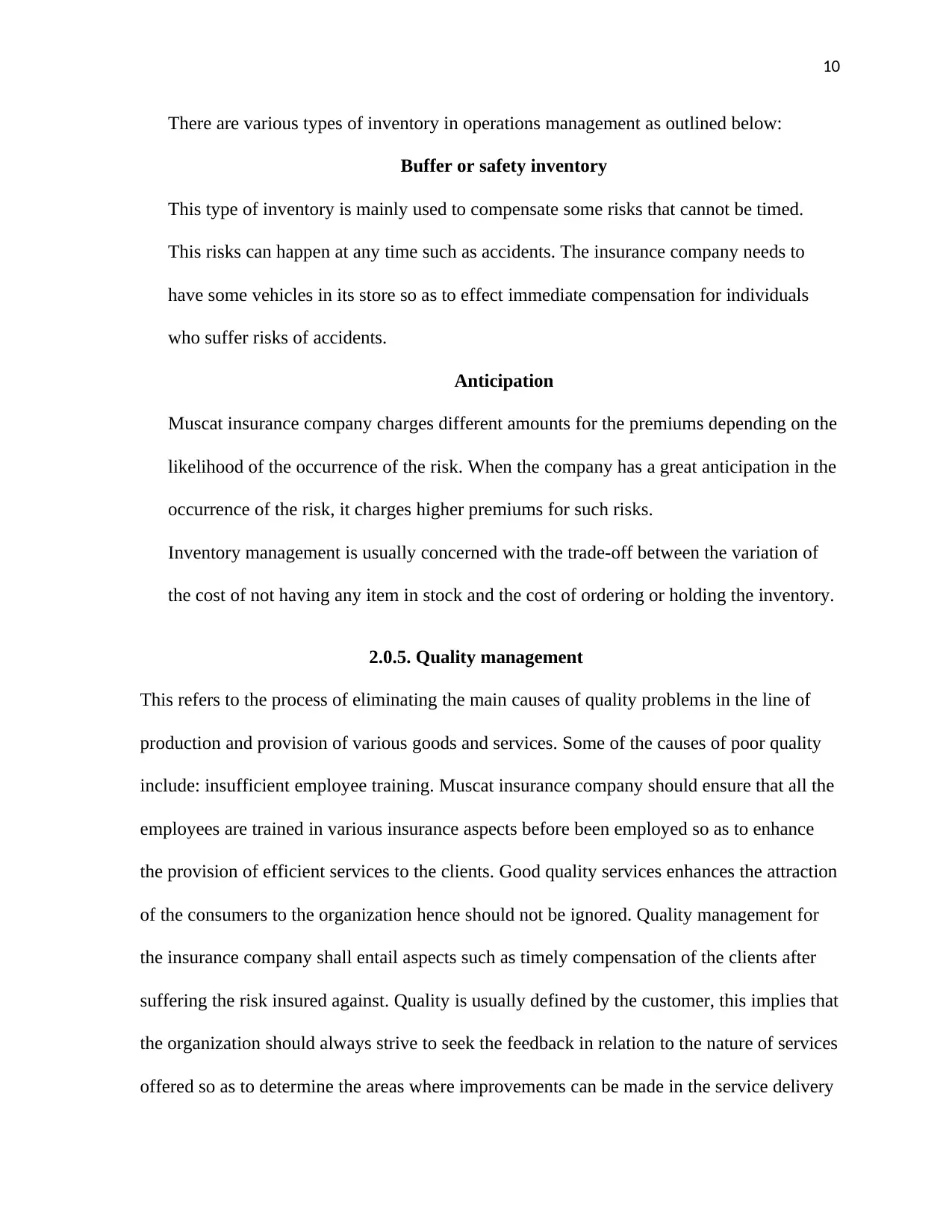
10
There are various types of inventory in operations management as outlined below:
Buffer or safety inventory
This type of inventory is mainly used to compensate some risks that cannot be timed.
This risks can happen at any time such as accidents. The insurance company needs to
have some vehicles in its store so as to effect immediate compensation for individuals
who suffer risks of accidents.
Anticipation
Muscat insurance company charges different amounts for the premiums depending on the
likelihood of the occurrence of the risk. When the company has a great anticipation in the
occurrence of the risk, it charges higher premiums for such risks.
Inventory management is usually concerned with the trade-off between the variation of
the cost of not having any item in stock and the cost of ordering or holding the inventory.
2.0.5. Quality management
This refers to the process of eliminating the main causes of quality problems in the line of
production and provision of various goods and services. Some of the causes of poor quality
include: insufficient employee training. Muscat insurance company should ensure that all the
employees are trained in various insurance aspects before been employed so as to enhance
the provision of efficient services to the clients. Good quality services enhances the attraction
of the consumers to the organization hence should not be ignored. Quality management for
the insurance company shall entail aspects such as timely compensation of the clients after
suffering the risk insured against. Quality is usually defined by the customer, this implies that
the organization should always strive to seek the feedback in relation to the nature of services
offered so as to determine the areas where improvements can be made in the service delivery
There are various types of inventory in operations management as outlined below:
Buffer or safety inventory
This type of inventory is mainly used to compensate some risks that cannot be timed.
This risks can happen at any time such as accidents. The insurance company needs to
have some vehicles in its store so as to effect immediate compensation for individuals
who suffer risks of accidents.
Anticipation
Muscat insurance company charges different amounts for the premiums depending on the
likelihood of the occurrence of the risk. When the company has a great anticipation in the
occurrence of the risk, it charges higher premiums for such risks.
Inventory management is usually concerned with the trade-off between the variation of
the cost of not having any item in stock and the cost of ordering or holding the inventory.
2.0.5. Quality management
This refers to the process of eliminating the main causes of quality problems in the line of
production and provision of various goods and services. Some of the causes of poor quality
include: insufficient employee training. Muscat insurance company should ensure that all the
employees are trained in various insurance aspects before been employed so as to enhance
the provision of efficient services to the clients. Good quality services enhances the attraction
of the consumers to the organization hence should not be ignored. Quality management for
the insurance company shall entail aspects such as timely compensation of the clients after
suffering the risk insured against. Quality is usually defined by the customer, this implies that
the organization should always strive to seek the feedback in relation to the nature of services
offered so as to determine the areas where improvements can be made in the service delivery
Paraphrase This Document
Need a fresh take? Get an instant paraphrase of this document with our AI Paraphraser
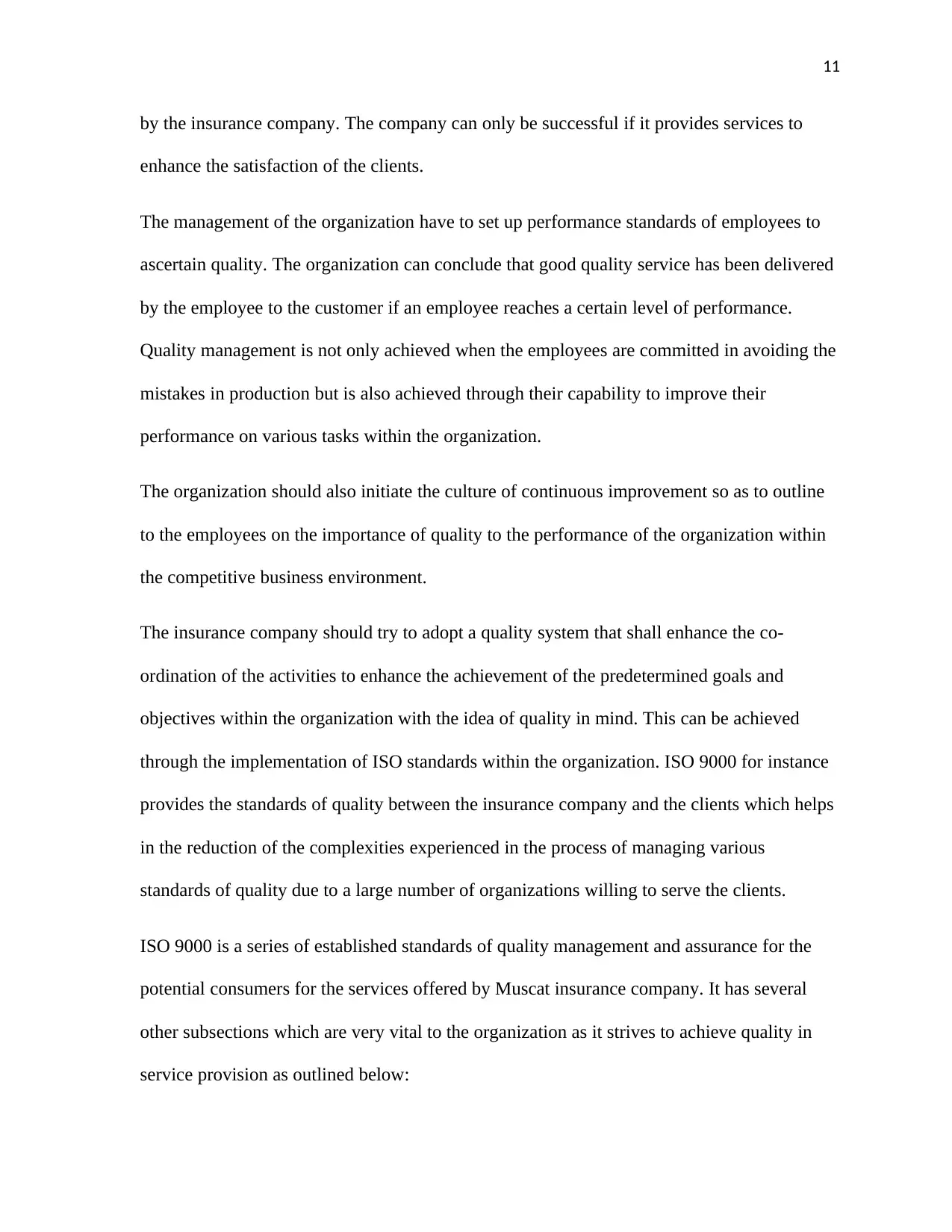
11
by the insurance company. The company can only be successful if it provides services to
enhance the satisfaction of the clients.
The management of the organization have to set up performance standards of employees to
ascertain quality. The organization can conclude that good quality service has been delivered
by the employee to the customer if an employee reaches a certain level of performance.
Quality management is not only achieved when the employees are committed in avoiding the
mistakes in production but is also achieved through their capability to improve their
performance on various tasks within the organization.
The organization should also initiate the culture of continuous improvement so as to outline
to the employees on the importance of quality to the performance of the organization within
the competitive business environment.
The insurance company should try to adopt a quality system that shall enhance the co-
ordination of the activities to enhance the achievement of the predetermined goals and
objectives within the organization with the idea of quality in mind. This can be achieved
through the implementation of ISO standards within the organization. ISO 9000 for instance
provides the standards of quality between the insurance company and the clients which helps
in the reduction of the complexities experienced in the process of managing various
standards of quality due to a large number of organizations willing to serve the clients.
ISO 9000 is a series of established standards of quality management and assurance for the
potential consumers for the services offered by Muscat insurance company. It has several
other subsections which are very vital to the organization as it strives to achieve quality in
service provision as outlined below:
by the insurance company. The company can only be successful if it provides services to
enhance the satisfaction of the clients.
The management of the organization have to set up performance standards of employees to
ascertain quality. The organization can conclude that good quality service has been delivered
by the employee to the customer if an employee reaches a certain level of performance.
Quality management is not only achieved when the employees are committed in avoiding the
mistakes in production but is also achieved through their capability to improve their
performance on various tasks within the organization.
The organization should also initiate the culture of continuous improvement so as to outline
to the employees on the importance of quality to the performance of the organization within
the competitive business environment.
The insurance company should try to adopt a quality system that shall enhance the co-
ordination of the activities to enhance the achievement of the predetermined goals and
objectives within the organization with the idea of quality in mind. This can be achieved
through the implementation of ISO standards within the organization. ISO 9000 for instance
provides the standards of quality between the insurance company and the clients which helps
in the reduction of the complexities experienced in the process of managing various
standards of quality due to a large number of organizations willing to serve the clients.
ISO 9000 is a series of established standards of quality management and assurance for the
potential consumers for the services offered by Muscat insurance company. It has several
other subsections which are very vital to the organization as it strives to achieve quality in
service provision as outlined below:
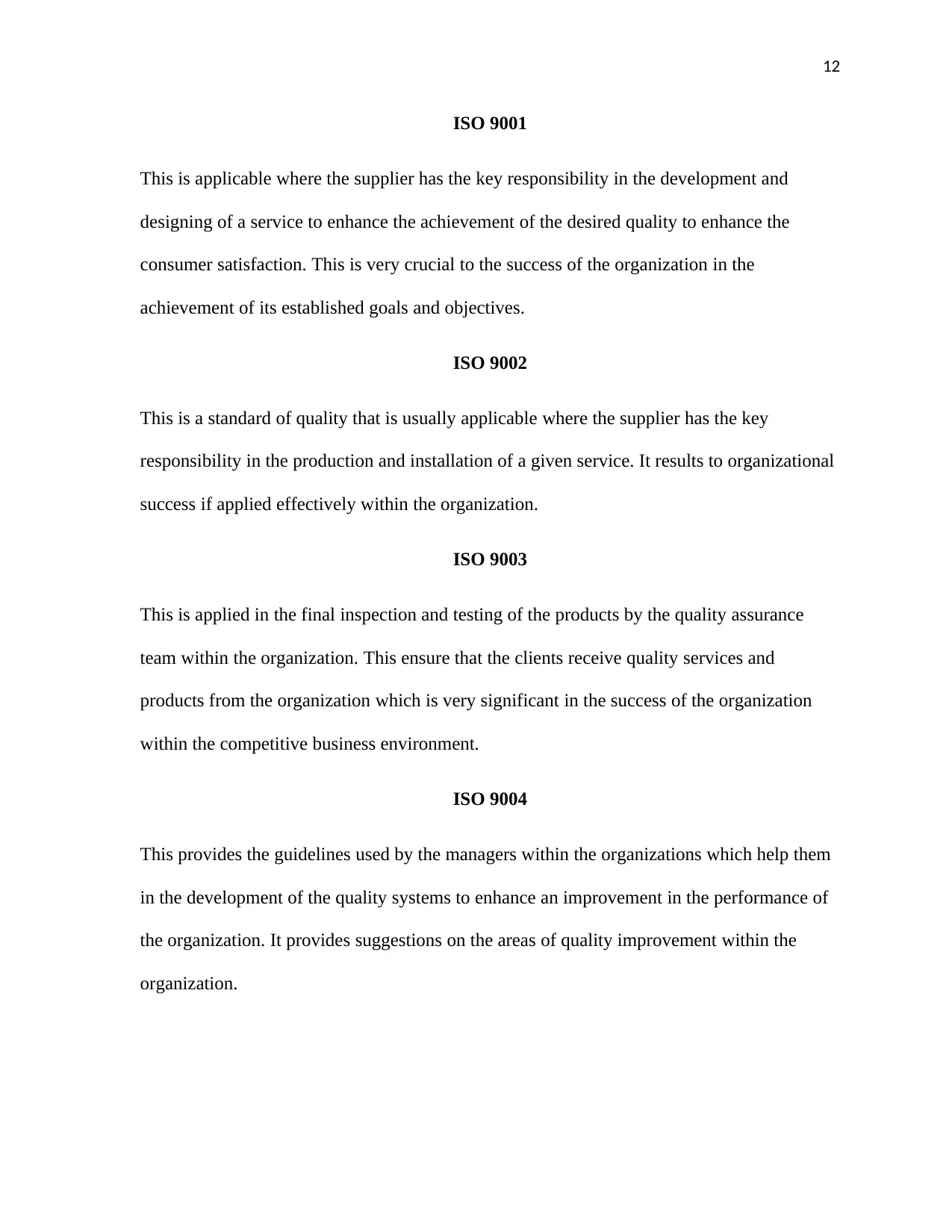
12
ISO 9001
This is applicable where the supplier has the key responsibility in the development and
designing of a service to enhance the achievement of the desired quality to enhance the
consumer satisfaction. This is very crucial to the success of the organization in the
achievement of its established goals and objectives.
ISO 9002
This is a standard of quality that is usually applicable where the supplier has the key
responsibility in the production and installation of a given service. It results to organizational
success if applied effectively within the organization.
ISO 9003
This is applied in the final inspection and testing of the products by the quality assurance
team within the organization. This ensure that the clients receive quality services and
products from the organization which is very significant in the success of the organization
within the competitive business environment.
ISO 9004
This provides the guidelines used by the managers within the organizations which help them
in the development of the quality systems to enhance an improvement in the performance of
the organization. It provides suggestions on the areas of quality improvement within the
organization.
ISO 9001
This is applicable where the supplier has the key responsibility in the development and
designing of a service to enhance the achievement of the desired quality to enhance the
consumer satisfaction. This is very crucial to the success of the organization in the
achievement of its established goals and objectives.
ISO 9002
This is a standard of quality that is usually applicable where the supplier has the key
responsibility in the production and installation of a given service. It results to organizational
success if applied effectively within the organization.
ISO 9003
This is applied in the final inspection and testing of the products by the quality assurance
team within the organization. This ensure that the clients receive quality services and
products from the organization which is very significant in the success of the organization
within the competitive business environment.
ISO 9004
This provides the guidelines used by the managers within the organizations which help them
in the development of the quality systems to enhance an improvement in the performance of
the organization. It provides suggestions on the areas of quality improvement within the
organization.
⊘ This is a preview!⊘
Do you want full access?
Subscribe today to unlock all pages.

Trusted by 1+ million students worldwide
1 out of 28
Related Documents
Your All-in-One AI-Powered Toolkit for Academic Success.
+13062052269
info@desklib.com
Available 24*7 on WhatsApp / Email
![[object Object]](/_next/static/media/star-bottom.7253800d.svg)
Unlock your academic potential
Copyright © 2020–2025 A2Z Services. All Rights Reserved. Developed and managed by ZUCOL.





